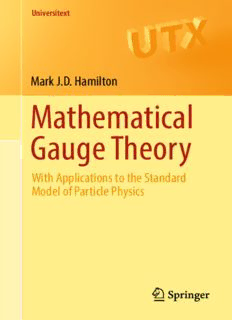Table Of ContentUniversitext
Mark J.D. Hamilton
Mathematical
Gauge Theory
With Applications to the Standard
Model of Particle Physics
Universitext
Universitext
Serieseditors
SheldonAxler
SanFranciscoStateUniversity
CarlesCasacuberta
UniversitatdeBarcelona
AngusMacIntyre
QueenMary,UniversityofLondon
KennethRibet
UniversityofCalifornia,Berkeley
ClaudeSabbah
Écolepolytechnique,CNRS,UniversitéParis-Saclay,Palaiseau
EndreSüli
UniversityofOxford
WojborA.Woyczyn´ski
CaseWesternReserveUniversity
Universitext is a series of textbooks that presents material from a wide variety
of mathematical disciplines at master’s level and beyond. The books, often well
class-tested by their author, may have an informal, personal even experimental
approachtotheirsubjectmatter.Someofthemostsuccessfulandestablishedbooks
intheserieshaveevolvedthroughseveraleditions,alwaysfollowingtheevolution
ofteachingcurricula,toverypolishedtexts.
Thus as research topics trickle down into graduate-level teaching, first textbooks
writtenfornew,cutting-edgecoursesmaymaketheirwayintoUniversitext.
Moreinformationaboutthisseriesathttp://www.springer.com/series/223
Mark J.D. Hamilton
Mathematical Gauge Theory
With Applications to the Standard Model
of Particle Physics
123
MarkJ.D.Hamilton
DepartmentofMathematics
Ludwig-MaximilianUniversityofMunich
Munich,Germany
ISSN0172-5939 ISSN2191-6675 (electronic)
Universitext
ISBN978-3-319-68438-3 ISBN978-3-319-68439-0 (eBook)
https://doi.org/10.1007/978-3-319-68439-0
LibraryofCongressControlNumber:2017957556
Mathematics Subject Classification (2010): 55R10, 53C05, 22E70, 15A66, 53C27, 57S15, 22E60,
81T13,81R40,81V19,81V05,81V10,81V15
©SpringerInternationalPublishingAG2017
Thisworkissubjecttocopyright.AllrightsarereservedbythePublisher,whetherthewholeorpartof
thematerialisconcerned,specificallytherightsoftranslation,reprinting,reuseofillustrations,recitation,
broadcasting,reproductiononmicrofilmsorinanyotherphysicalway,andtransmissionorinformation
storageandretrieval,electronicadaptation,computersoftware,orbysimilarordissimilarmethodology
nowknownorhereafterdeveloped.
Theuseofgeneraldescriptivenames,registerednames,trademarks,servicemarks,etc.inthispublication
doesnotimply,evenintheabsenceofaspecificstatement,thatsuchnamesareexemptfromtherelevant
protectivelawsandregulationsandthereforefreeforgeneraluse.
Thepublisher,theauthorsandtheeditorsaresafetoassumethattheadviceandinformationinthisbook
arebelievedtobetrueandaccurateatthedateofpublication.Neitherthepublishernortheauthorsor
theeditorsgiveawarranty,expressorimplied,withrespecttothematerialcontainedhereinorforany
errorsoromissionsthatmayhavebeenmade.Thepublisherremainsneutralwithregardtojurisdictional
claimsinpublishedmapsandinstitutionalaffiliations.
Printedonacid-freepaper
ThisSpringerimprintispublishedbySpringerNature
TheregisteredcompanyisSpringerInternationalPublishingAG
Theregisteredcompanyaddressis:Gewerbestrasse11,6330Cham,Switzerland
Dedicatedtomy fatherand mymother
Preface
With the discovery of a new particle, announced on 4 July 2012 at CERN,
whosepropertiesare“consistentwiththelong-soughtHiggsboson”[31],thefinal
elementary particle predicted by the classical Standard Model of particle physics
hasbeenfound.Theaimofthisbookistoexplainthemathematicalbackgroundas
wellassomeofthedetailsoftheStandardModel.Itisdirectedbothatstudentsof
mathematics,whoareinterestedinapplicationsofgaugetheoryin physics,andat
studentsofphysics,whowouldliketounderstandmoreofthemathematicsbehind
theStandardModel.
ThebookisbasedonmylecturenotesforgraduatecoursesheldattheUniversity
of Stuttgartand the LMU Munichin Germany.A selection of the materialcan be
coveredinonesemester.Prerequisitesareanintroductorycourseonmanifoldsand
differential geometry as well as some basic knowledge of special relativity, sum-
marizedin the appendix.The first six chaptersof the booktreat the mathematical
frameworkofgaugetheories,inparticularLiegroups,Liealgebras,representations,
groupactions,fibrebundles,connectionsandcurvature,andspinors.Thefollowing
three chaptersdiscuss applicationsin physics:the Lagrangiansand interactionsin
theStandardModel,spontaneoussymmetrybreaking,theHiggsmechanismofmass
generation,and some more advancedand moderntopics like neutrinomasses, CP
violationandGrandUnification.
The background in mathematics covered in the first six chapters of the book
ismuchmoreextensivethanstrictlyneededtounderstandtheStandardModel.For
example,theStandardModelisformulatedon4-dimensionalMinkowskispacetime,
over which all fibre bundles can be trivialized and spinors have a simple explicit
description. However, this book is also intended as an introduction to modern
theoreticalphysicsas a whole, andsome of the topics(forinstance, on spinorsor
non-trivialfibrebundles)maybeusefultostudentswhoplantostudytopicssuchas
supersymmetryorsuperstringtheory.Dependingonthetime,theinterestsandthe
priorknowledgeofthereader,he orshe cantake a shortcutandimmediatelystart
at the chapters on connections, spinors or Lagrangians, and then go back if more
detailedmathematicalknowledgeisrequiredatsomepoint.
vii
viii Preface
SincewefocusontheStandardModel,severaltopicsrelatedtogaugetheoryand
fibrebundlescouldnotbecovered,suchascharacteristicclasses,holonomytheory,
indextheorems,monopolesandinstantonsaswellasapplicationsofgaugetheory
inpuremathematics,likeDonaldsonandSeiberg–Wittentheory.Forthosetopicsa
numberoftextbooksexist,someofwhichcanbefoundinthebibliography.
An interesting and perhaps underappreciated fact is that a substantial number
of phenomena in particle physics can be understood by analysing representations
of Lie groups and by rewriting or rearranging Lagrangians. Examples of such
phenomena,whichwearegoingtostudy,are:
(cid:129) symmetriesofLagrangians
(cid:129) interactions between fields corresponding to elementary particles (quarks, lep-
tons,gaugebosons,Higgsboson),determinedbytheLagrangian
(cid:129) the Higgsmechanismof massgenerationforgaugebosonsaswellas the mass
generationforfermionsviaYukawacouplings
(cid:129) quarkandneutrinomixing
(cid:129) neutrinomassesandtheseesawmechanism
(cid:129) CPviolation
(cid:129) GrandUnification
Ontheotherhand,ifprecisepredictionsaboutscatteringordecayofparticlesshould
bemadeorifexplicitformulasforquantumeffects,suchasanomaliesandrunning
couplings, should be derived, then quantum field calculations involving Green’s
functions,perturbationtheoryandrenormalizationarenecessary.Thesecalculations
arebeyondthescopeofthisbook,butanumberoftextbookscoveringthesetopics
canbefoundinthephysicsliterature.
ThereferencesIusedduringthepreparationofthebookarelistedineachchapter
and may be useful to the reader for further studies (this is only a selection of
references that I came across over the past several years, sometimes by chance,
andtherearemanyothervaluablebooksandarticlesinthisfield).
Itisnoteasy tomakea recommendationonhowto fitthe chaptersofthebook
intoalecturecourse,becauseitdependsonthepriorknowledgeoftheaudience.A
roughguidelinecouldbeasfollows:
(cid:129) One-semestercourse:Oftenlecturecoursesondifferentiablemanifoldscontain
sections on Lie groups, Lie algebras and group actions. If these topics can be
assumedaspriorknowledge,thenonecouldcoveringaugetheorytheunstarred
sectionsofChaps.4to7andasmuchaspossibleofChap.8,perhapsgoingback
toChaps.1to3ifspecificresultsareneeded.
(cid:129) Two-semester course: Depending on the prior knowledge of the audience, one
could coverin the first semester Chaps.4 to 6 in moredetailand in the second
semesterChaps.7to9.OronecouldcoverinthefirstsemesterChaps.1to5and
inthesecondsemesterChaps.6to8(andasmuchaspossibleofChap.9).
Munich,Germany MarkJ.D.Hamilton
July2017
Acknowledgements
ThereareseveralpeopleandinstitutionsIwouldliketothank.First,Iamgratefulto
Dieter Kotschick andUwe Semmelmannfor their academicand scientific support
since my time as a student. I want to thank Tian-Jun Li for our mathematical
discussionsandtheinvitationtoconferencesinMinneapolis,andtheSimonsCenter
for Geometry and Physics for the invitation to a workshop in Stony Brook. I
wouldalsolike totaketheopportunitytothank(belatedly)theGermanAcademic
ScholarshipFoundation(Studienstiftung)fortheirgenerousfinancialsupportduring
myyearsofstudy.
I am grateful to the LMU Munich and the University of Stuttgart for the
opportunity to give lecture courses on mathematical gauge theory, which formed
the basis for this book. I want to thank the students who attended the lectures, in
particular, Ismail Achmed-Zade, Anthony Britto, Simon-Raphael Fischer, Simon
Hirscher, Martin Peev, Alexander Tabler, Danu Thung, Juraj Vrábel and David
Wierichs, as well as my course assistants Nicola Pia and Giovanni Placini for
readingthelecturenotesandcommentingonthemanuscript.Furthermore,Iwould
liketo thankBobbyAcharyaforhisexcellentlecturesontheStandardModeland
RobertHellingandRonenPlesserforourinterestingdiscussionsaboutphysics.
SpecialthankstoCatrionaByrne,myfirstcontactatSpringer,toRémiLodhfor
hisexcellenteditorialsupportandsuggestionswhileIwaswritingthemanuscript,
totheanonymousreferees,theeditorsandthecopyeditorforanumberofcomments
andcorrections,andtoAnne-KathrinBirchley-Brunforassistanceintheproduction
andpublicationofthebook.
Finally, I am grateful to John, Barbara and Patrick Hamilton, Gisela Saalfeld
andIngeSchmidbauerfortheir encouragementandsupportoverthe years, andto
GuoshuWangforherfriendship.
ix
Conventions
Wecollectsomeconventionsthatareusedthroughoutthebook.
General
(cid:129) Sectionsandsubsectionsmarkedwitha(cid:2) infrontofthetitlecontainadditional
or advancedmaterial and can be skipped on a first reading.Occasionally these
sectionsareusedinlaterchapters.
(cid:129) Awordinitalicsissometimesusedforemphasis,butmoreoftentodenoteterms
that have not been defined so far in the text, like gauge boson, or to denote
standardterms,likeskewfield,whosedefinitioncanbefoundinmanytextbooks.
Awordinboldfaceisusuallyusedfordefinitions.
(cid:129) Diffeomorphismsofmanifoldsandisomorphismsofvectorspaces,groups,Lie
groups,algebrasandbundlesaredenotedbyŠ.
(cid:129) We often use the Einstein summation convention byPsumming over the same
indicesin anexpression,withoutwritingthesymbol (wealso sumovertwo
lowerortwoupperindices).
(cid:129) IfAisaset,thenIdAWA!AdenotestheidSentitymap.
(cid:129) Adisjointunionofsetsisdenotedby[P or P.
(cid:129) ThesymbolsReandImdenotetherealandimaginarypartofacomplexnumber
(andsometimesofaquaternion).
LinearAlgebra
(cid:129) WedenotebyMat.n(cid:2)m;R/thesetofn(cid:2)m-matriceswithentriesinaringR.
xi
Description:The Standard Model is the foundation of modern particle and high energy physics. This book explains the mathematical background behind the Standard Model, translating ideas from physics into a mathematical language and vice versa.The first part of the book covers the mathematical theory of Lie group

